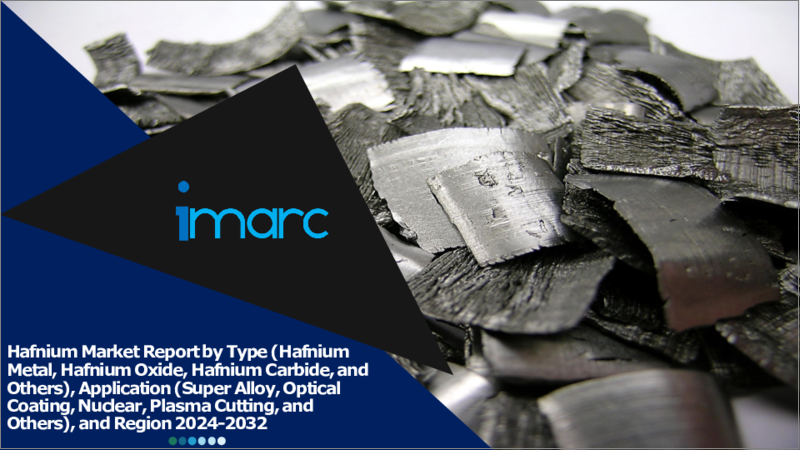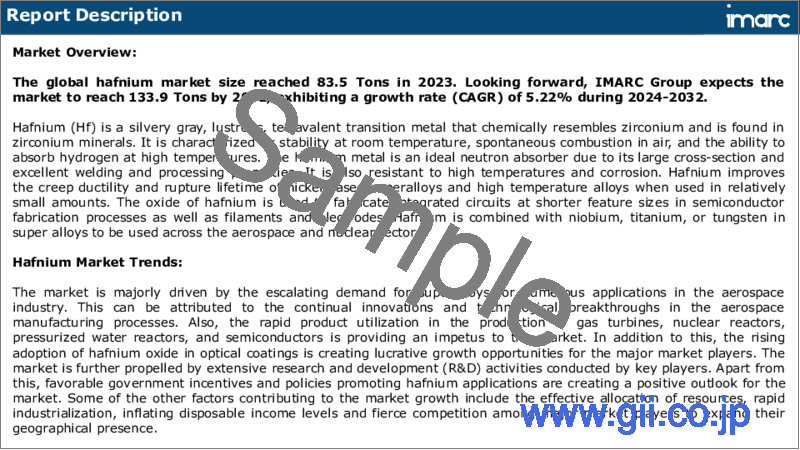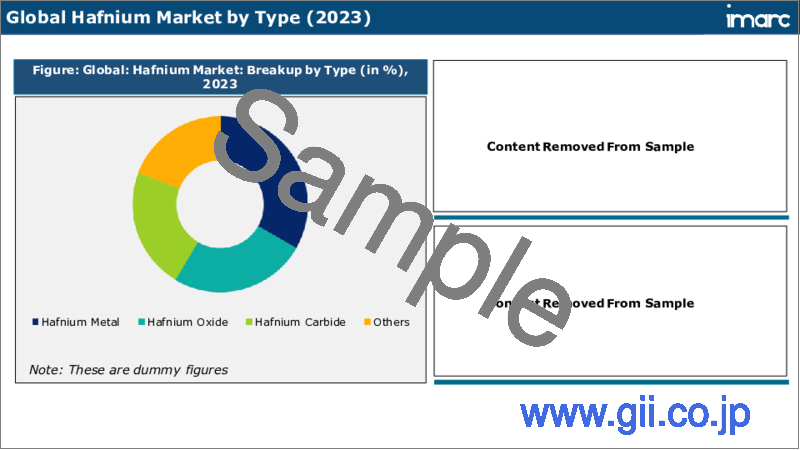|
|
市場調査レポート
商品コード
1468568
ハフニウム市場レポート:タイプ、用途、地域別、2024~2032年Hafnium Market Report by Type (Hafnium Metal, Hafnium Oxide, Hafnium Carbide, and Others), Application (Super Alloy, Optical Coating, Nuclear, Plasma Cutting, and Others), and Region 2024-2032 |
||||||
カスタマイズ可能
|
|||||||
| ハフニウム市場レポート:タイプ、用途、地域別、2024~2032年 |
|
出版日: 2024年04月08日
発行: IMARC
ページ情報: 英文 138 Pages
納期: 2~3営業日
|
- 全表示
- 概要
- 図表
- 目次
世界のハフニウム市場規模は2023年に83.5トンに達しました。IMARC Groupは、2032年には133.9トンに達し、2024~2032年の成長率(CAGR)は5.22%になると予測しています。
ハフニウム(Hf)は銀灰色で光沢のある4価の遷移金属で、化学的にはジルコニウムに似ており、ジルコニウム鉱物に含まれています。室温で安定し、空気中で自然発火し、高温で水素を吸収する性質があります。ハフニウム金属は断面積が大きく、溶接や加工特性に優れているため、理想的な中性子吸収材です。また、高温や腐食にも強いです。ハフニウムは、比較的少量使用することで、ニッケル基超合金や高温合金のクリープ延性や破断寿命を向上させる。ハフニウムの酸化物は、フィラメントや電極だけでなく、半導体製造工程でより短いフィーチャサイズで集積回路を製造するためにも使用されます。ハフニウムは、ニオブ、チタン、タングステンと組み合わされた超合金として、航空宇宙セグメントや原子力セグメントで使用されています。
ハフニウム市場の動向:
ハフニウム市場の主要原動力は、航空宇宙産業における様々な用途の超合金に対する需要の高まりです。これは、航空宇宙製造プロセスにおける絶え間ない革新と技術的ブレークスルーに起因します。また、ガスタービン、原子炉、加圧水型原子炉、半導体の生産における急速な製品利用が市場に弾みをつけています。これに加えて、光学コーティングへの酸化ハフニウムの採用が増加していることも、主要な市場参入企業に有利な成長機会をもたらしています。さらに、新興国市場は、主要参入企業による広範な研究開発(R&D)活動によって後押しされています。これとは別に、ハフニウムの応用を促進する政府の優遇措置や政策が、市場に明るい展望をもたらしています。市場成長に寄与するその他の要因としては、資源の効果的な配分、急速な工業化、可処分所得水準の上昇、地理的プレゼンス拡大のための主要市場参入企業間の熾烈な競争などが挙げられます。
本レポートで扱う主要質問
- 2023年の世界ハフニウム市場規模は?
- 2024~2032年にかけてのハフニウム世界市場の予想成長率は?
- ハフニウムの世界市場を牽引する主要因は?
- COVID-19がハフニウムの世界市場に与えた影響は?
- ハフニウムの世界市場のタイプ別区分は?
- ハフニウムの世界市場の用途別区分は?
- ハフニウムの世界市場における主要地域は?
- ハフニウムの世界市場における主要参入企業は?
目次
第1章 序文
第2章 調査範囲と調査手法
- 調査目的
- 利害関係者
- データソース
- 一次情報
- 二次情報
- 市場推定
- ボトムアップアプローチ
- トップダウンアプローチ
- 調査手法
第3章 エグゼクティブサマリー
第4章 イントロダクション
- 概要
- 主要産業動向
第5章 ハフニウムの世界市場
- 市場概要
- 市場実績
- COVID-19の影響
- 市場予測
第6章 市場内訳:タイプ別
- ハフニウム金属
- 酸化ハフニウム
- 炭化ハフニウム
- その他
第7章 市場内訳:用途別
- 超合金
- 市場動向
- 市場展望
- 光学コーティング
- 原子力
- プラズマ切断
- その他
第8章 市場内訳:地域別
- 北米
- 米国
- カナダ
- アジア太平洋
- 中国
- 日本
- インド
- 韓国
- オーストラリア
- インドネシア
- その他
- 欧州
- ドイツ
- フランス
- 英国
- イタリア
- スペイン
- ロシア
- その他
- ラテンアメリカ
- ブラジル
- メキシコ
- その他
- 中東・アフリカ
- 市場動向
- 市場内訳:国別
- 市場予測
第9章 SWOT分析
- 概要
- 強み
- 弱み
- 機会
- 脅威
第10章 バリューチェーン分析
第11章 ポーターのファイブフォース分析
- 概要
- 買い手の交渉力
- 供給企業の交渉力
- 競合の程度
- 新規参入業者の脅威
- 代替品の脅威
第12章 価格分析
第13章 競合情勢
- 市場構造
- 主要企業
- 主要企業のプロファイル
- ACI Alloys
- Alkane Resources Ltd
- Allegheny Technologies Incorporated(ATI)
- American Elements
- Chemsavers Inc.
- China Nulear JingHuan Zirconium Industry Co. Ltd.
- Framatome(Electricite de France S.A.)
- Lenntech B.V.
- Nanjing Youtian Metal Technology Co. Ltd.
- Phelly Materials Inc.
- Thermo Fisher Scientific Inc.
List of Figures
- Figure 1: Global: Hafnium Market: Major Drivers and Challenges
- Figure 2: Global: Hafnium Market: Volume Trends (in Tons), 2018-2023
- Figure 3: Global: Hafnium Market Forecast: Volume Trends (in Tons), 2024-2032
- Figure 4: Global: Hafnium Market: Sales Value (in Million US$), 2018-2023
- Figure 5: Global: Hafnium Market Forecast: Sales Value (in Million US$), 2024-2032
- Figure 6: Global: Hafnium Market: Breakup by Type (in %), 2023
- Figure 7: Global: Hafnium Market: Breakup by Application (in %), 2023
- Figure 8: Global: Hafnium Market: Breakup by Region (in %), 2023
- Figure 9: Global: Hafnium (Hafnium Metal) Market: Sales Value (in Million US$), 2018 & 2023
- Figure 10: Global: Hafnium (Hafnium Metal) Market Forecast: Sales Value (in Million US$), 2024-2032
- Figure 11: Global: Hafnium (Hafnium Oxide) Market: Sales Value (in Million US$), 2018 & 2023
- Figure 12: Global: Hafnium (Hafnium Oxide) Market Forecast: Sales Value (in Million US$), 2024-2032
- Figure 13: Global: Hafnium (Hafnium Carbide) Market: Sales Value (in Million US$), 2018 & 2023
- Figure 14: Global: Hafnium (Hafnium Carbide) Market Forecast: Sales Value (in Million US$), 2024-2032
- Figure 15: Global: Hafnium (Other Types) Market: Sales Value (in Million US$), 2018 & 2023
- Figure 16: Global: Hafnium (Other Types) Market Forecast: Sales Value (in Million US$), 2024-2032
- Figure 17: Global: Hafnium (Super Alloy) Market: Sales Value (in Million US$), 2018 & 2023
- Figure 18: Global: Hafnium (Super Alloy) Market Forecast: Sales Value (in Million US$), 2024-2032
- Figure 19: Global: Hafnium (Optical Coating) Market: Sales Value (in Million US$), 2018 & 2023
- Figure 20: Global: Hafnium (Optical Coating) Market Forecast: Sales Value (in Million US$), 2024-2032
- Figure 21: Global: Hafnium (Nuclear) Market: Sales Value (in Million US$), 2018 & 2023
- Figure 22: Global: Hafnium (Nuclear) Market Forecast: Sales Value (in Million US$), 2024-2032
- Figure 23: Global: Hafnium (Plasma Cutting) Market: Sales Value (in Million US$), 2018 & 2023
- Figure 24: Global: Hafnium (Plasma Cutting) Market Forecast: Sales Value (in Million US$), 2024-2032
- Figure 25: Global: Hafnium (Other Applications) Market: Sales Value (in Million US$), 2018 & 2023
- Figure 26: Global: Hafnium (Other Applications) Market Forecast: Sales Value (in Million US$), 2024-2032
- Figure 27: North America: Hafnium Market: Sales Value (in Million US$), 2018 & 2023
- Figure 28: North America: Hafnium Market Forecast: Sales Value (in Million US$), 2024-2032
- Figure 29: United States: Hafnium Market: Sales Value (in Million US$), 2018 & 2023
- Figure 30: United States: Hafnium Market Forecast: Sales Value (in Million US$), 2024-2032
- Figure 31: Canada: Hafnium Market: Sales Value (in Million US$), 2018 & 2023
- Figure 32: Canada: Hafnium Market Forecast: Sales Value (in Million US$), 2024-2032
- Figure 33: Asia-Pacific: Hafnium Market: Sales Value (in Million US$), 2018 & 2023
- Figure 34: Asia-Pacific: Hafnium Market Forecast: Sales Value (in Million US$), 2024-2032
- Figure 35: China: Hafnium Market: Sales Value (in Million US$), 2018 & 2023
- Figure 36: China: Hafnium Market Forecast: Sales Value (in Million US$), 2024-2032
- Figure 37: Japan: Hafnium Market: Sales Value (in Million US$), 2018 & 2023
- Figure 38: Japan: Hafnium Market Forecast: Sales Value (in Million US$), 2024-2032
- Figure 39: India: Hafnium Market: Sales Value (in Million US$), 2018 & 2023
- Figure 40: India: Hafnium Market Forecast: Sales Value (in Million US$), 2024-2032
- Figure 41: South Korea: Hafnium Market: Sales Value (in Million US$), 2018 & 2023
- Figure 42: South Korea: Hafnium Market Forecast: Sales Value (in Million US$), 2024-2032
- Figure 43: Australia: Hafnium Market: Sales Value (in Million US$), 2018 & 2023
- Figure 44: Australia: Hafnium Market Forecast: Sales Value (in Million US$), 2024-2032
- Figure 45: Indonesia: Hafnium Market: Sales Value (in Million US$), 2018 & 2023
- Figure 46: Indonesia: Hafnium Market Forecast: Sales Value (in Million US$), 2024-2032
- Figure 47: Others: Hafnium Market: Sales Value (in Million US$), 2018 & 2023
- Figure 48: Others: Hafnium Market Forecast: Sales Value (in Million US$), 2024-2032
- Figure 49: Europe: Hafnium Market: Sales Value (in Million US$), 2018 & 2023
- Figure 50: Europe: Hafnium Market Forecast: Sales Value (in Million US$), 2024-2032
- Figure 51: Germany: Hafnium Market: Sales Value (in Million US$), 2018 & 2023
- Figure 52: Germany: Hafnium Market Forecast: Sales Value (in Million US$), 2024-2032
- Figure 53: France: Hafnium Market: Sales Value (in Million US$), 2018 & 2023
- Figure 54: France: Hafnium Market Forecast: Sales Value (in Million US$), 2024-2032
- Figure 55: United Kingdom: Hafnium Market: Sales Value (in Million US$), 2018 & 2023
- Figure 56: United Kingdom: Hafnium Market Forecast: Sales Value (in Million US$), 2024-2032
- Figure 57: Italy: Hafnium Market: Sales Value (in Million US$), 2018 & 2023
- Figure 58: Italy: Hafnium Market Forecast: Sales Value (in Million US$), 2024-2032
- Figure 59: Spain: Hafnium Market: Sales Value (in Million US$), 2018 & 2023
- Figure 60: Spain: Hafnium Market Forecast: Sales Value (in Million US$), 2024-2032
- Figure 61: Russia: Hafnium Market: Sales Value (in Million US$), 2018 & 2023
- Figure 62: Russia: Hafnium Market Forecast: Sales Value (in Million US$), 2024-2032
- Figure 63: Others: Hafnium Market: Sales Value (in Million US$), 2018 & 2023
- Figure 64: Others: Hafnium Market Forecast: Sales Value (in Million US$), 2024-2032
- Figure 65: Latin America: Hafnium Market: Sales Value (in Million US$), 2018 & 2023
- Figure 66: Latin America: Hafnium Market Forecast: Sales Value (in Million US$), 2024-2032
- Figure 67: Brazil: Hafnium Market: Sales Value (in Million US$), 2018 & 2023
- Figure 68: Brazil: Hafnium Market Forecast: Sales Value (in Million US$), 2024-2032
- Figure 69: Mexico: Hafnium Market: Sales Value (in Million US$), 2018 & 2023
- Figure 70: Mexico: Hafnium Market Forecast: Sales Value (in Million US$), 2024-2032
- Figure 71: Others: Hafnium Market: Sales Value (in Million US$), 2018 & 2023
- Figure 72: Others: Hafnium Market Forecast: Sales Value (in Million US$), 2024-2032
- Figure 73: Middle East and Africa: Hafnium Market: Sales Value (in Million US$), 2018 & 2023
- Figure 74: Middle East and Africa: Hafnium Market: Breakup by Country (in %), 2023
- Figure 75: Middle East and Africa: Hafnium Market Forecast: Sales Value (in Million US$), 2024-2032
- Figure 76: Global: Hafnium Industry: SWOT Analysis
- Figure 77: Global: Hafnium Industry: Value Chain Analysis
- Figure 78: Global: Hafnium Industry: Porter's Five Forces Analysis
List of Tables
- Table 1: Global: Hafnium Market: Key Industry Highlights, 2023 and 2032
- Table 2: Global: Hafnium Market Forecast: Breakup by Type (in Million US$), 2024-2032
- Table 3: Global: Hafnium Market Forecast: Breakup by Application (in Million US$), 2024-2032
- Table 4: Global: Hafnium Market Forecast: Breakup by Region (in Million US$), 2024-2032
- Table 5: Global: Hafnium Market: Competitive Structure
- Table 6: Global: Hafnium Market: Key Players
The global hafnium market size reached 83.5 Tons in 2023. Looking forward, IMARC Group expects the market to reach 133.9 Tons by 2032, exhibiting a growth rate (CAGR) of 5.22% during 2024-2032.
Hafnium (Hf) is a silvery gray, lustrous, tetravalent transition metal that chemically resembles zirconium and is found in zirconium minerals. It is characterized by stability at room temperature, spontaneous combustion in air, and the ability to absorb hydrogen at high temperatures. The hafnium metal is an ideal neutron absorber due to its large cross-section and excellent welding and processing properties. It is also resistant to high temperatures and corrosion. Hafnium improves the creep ductility and rupture lifetime of nickel-based superalloys and high temperature alloys when used in relatively small amounts. The oxide of hafnium is used to fabricate integrated circuits at shorter feature sizes in semiconductor fabrication processes as well as filaments and electrodes. Hafnium is combined with niobium, titanium, or tungsten in super alloys to be used across the aerospace and nuclear sectors.
Hafnium Market Trends:
The market is majorly driven by the escalating demand for superalloys for numerous applications in the aerospace industry. This can be attributed to the continual innovations and technological breakthroughs in the aerospace manufacturing processes. Also, the rapid product utilization in the production of gas turbines, nuclear reactors, pressurized water reactors, and semiconductors is providing an impetus to the market. In addition to this, the rising adoption of hafnium oxide in optical coatings is creating lucrative growth opportunities for the major market players. The market is further propelled by extensive research and development (R&D) activities conducted by key players. Apart from this, favorable government incentives and policies promoting hafnium applications are creating a positive outlook for the market. Some of the other factors contributing to the market growth include the effective allocation of resources, rapid industrialization, inflating disposable income levels and fierce competition among major market players to expand their geographical presence.
Key Market Segmentation:
IMARC Group provides an analysis of the key trends in each sub-segment of the global hafnium market report, along with forecasts at the global, regional and country level from 2024-2032. Our report has categorized the market based on type and application.
Breakup by Type:
Hafnium Metal
Hafnium Oxide
Hafnium Carbide
Others
Breakup by Application:
Super Alloy
Optical Coating
Nuclear
Plasma Cutting
Others
Breakup by Region:
North America
United States
Canada
Asia-Pacific
China
Japan
India
South Korea
Australia
Indonesia
Others
Europe
Germany
France
United Kingdom
Italy
Spain
Russia
Others
Latin America
Brazil
Mexico
Others
Middle East and Africa
Competitive Landscape:
The competitive landscape of the industry has also been examined along with the profiles of the key players being ACI Alloys, Alkane Resources Ltd, Allegheny Technologies Incorporated (ATI), American Elements, Chemsavers Inc., China Nulear JingHuan Zirconium Industry Co. Ltd., Framatome (Electricite de France S.A.), Lenntech B.V., Nanjing Youtian Metal Technology Co. Ltd., Phelly Materials Inc. and Thermo Fisher Scientific Inc.
Key Questions Answered in This Report
- 1. What was the size of the global hafnium market in 2023?
- 2. What is the expected growth rate of the global hafnium market during 2024-2032?
- 3. What are the key factors driving the global hafnium market?
- 4. What has been the impact of COVID-19 on the global hafnium market?
- 5. What is the breakup of the global hafnium market based on the type?
- 6. What is the breakup of the global hafnium market based on the application?
- 7. What are the key regions in the global hafnium market?
- 8. Who are the key players/companies in the global hafnium market?
Table of Contents
1 Preface
2 Scope and Methodology
- 2.1 Objectives of the Study
- 2.2 Stakeholders
- 2.3 Data Sources
- 2.3.1 Primary Sources
- 2.3.2 Secondary Sources
- 2.4 Market Estimation
- 2.4.1 Bottom-Up Approach
- 2.4.2 Top-Down Approach
- 2.5 Forecasting Methodology
3 Executive Summary
4 Introduction
- 4.1 Overview
- 4.2 Key Industry Trends
5 Global Hafnium Market
- 5.1 Market Overview
- 5.2 Market Performance
- 5.3 Impact of COVID-19
- 5.4 Market Forecast
6 Market Breakup by Type
- 6.1 Hafnium Metal
- 6.1.1 Market Trends
- 6.1.2 Market Forecast
- 6.2 Hafnium Oxide
- 6.2.1 Market Trends
- 6.2.2 Market Forecast
- 6.3 Hafnium Carbide
- 6.3.1 Market Trends
- 6.3.2 Market Forecast
- 6.4 Others
- 6.4.1 Market Trends
- 6.4.2 Market Forecast
7 Market Breakup by Application
- 7.1 Super Alloy
- 7.1.1 Market Trends
- 7.1.2 Market Forecast
- 7.2 Optical Coating
- 7.2.1 Market Trends
- 7.2.2 Market Forecast
- 7.3 Nuclear
- 7.3.1 Market Trends
- 7.3.2 Market Forecast
- 7.4 Plasma Cutting
- 7.4.1 Market Trends
- 7.4.2 Market Forecast
- 7.5 Others
- 7.5.1 Market Trends
- 7.5.2 Market Forecast
8 Market Breakup by Region
- 8.1 North America
- 8.1.1 United States
- 8.1.1.1 Market Trends
- 8.1.1.2 Market Forecast
- 8.1.2 Canada
- 8.1.2.1 Market Trends
- 8.1.2.2 Market Forecast
- 8.1.1 United States
- 8.2 Asia-Pacific
- 8.2.1 China
- 8.2.1.1 Market Trends
- 8.2.1.2 Market Forecast
- 8.2.2 Japan
- 8.2.2.1 Market Trends
- 8.2.2.2 Market Forecast
- 8.2.3 India
- 8.2.3.1 Market Trends
- 8.2.3.2 Market Forecast
- 8.2.4 South Korea
- 8.2.4.1 Market Trends
- 8.2.4.2 Market Forecast
- 8.2.5 Australia
- 8.2.5.1 Market Trends
- 8.2.5.2 Market Forecast
- 8.2.6 Indonesia
- 8.2.6.1 Market Trends
- 8.2.6.2 Market Forecast
- 8.2.7 Others
- 8.2.7.1 Market Trends
- 8.2.7.2 Market Forecast
- 8.2.1 China
- 8.3 Europe
- 8.3.1 Germany
- 8.3.1.1 Market Trends
- 8.3.1.2 Market Forecast
- 8.3.2 France
- 8.3.2.1 Market Trends
- 8.3.2.2 Market Forecast
- 8.3.3 United Kingdom
- 8.3.3.1 Market Trends
- 8.3.3.2 Market Forecast
- 8.3.4 Italy
- 8.3.4.1 Market Trends
- 8.3.4.2 Market Forecast
- 8.3.5 Spain
- 8.3.5.1 Market Trends
- 8.3.5.2 Market Forecast
- 8.3.6 Russia
- 8.3.6.1 Market Trends
- 8.3.6.2 Market Forecast
- 8.3.7 Others
- 8.3.7.1 Market Trends
- 8.3.7.2 Market Forecast
- 8.3.1 Germany
- 8.4 Latin America
- 8.4.1 Brazil
- 8.4.1.1 Market Trends
- 8.4.1.2 Market Forecast
- 8.4.2 Mexico
- 8.4.2.1 Market Trends
- 8.4.2.2 Market Forecast
- 8.4.3 Others
- 8.4.3.1 Market Trends
- 8.4.3.2 Market Forecast
- 8.4.1 Brazil
- 8.5 Middle East and Africa
- 8.5.1 Market Trends
- 8.5.2 Market Breakup by Country
- 8.5.3 Market Forecast
9 SWOT Analysis
- 9.1 Overview
- 9.2 Strengths
- 9.3 Weaknesses
- 9.4 Opportunities
- 9.5 Threats
10 Value Chain Analysis
11 Porters Five Forces Analysis
- 11.1 Overview
- 11.2 Bargaining Power of Buyers
- 11.3 Bargaining Power of Suppliers
- 11.4 Degree of Competition
- 11.5 Threat of New Entrants
- 11.6 Threat of Substitutes
12 Price Analysis
13 Competitive Landscape
- 13.1 Market Structure
- 13.2 Key Players
- 13.3 Profiles of Key Players
- 13.3.1 ACI Alloys
- 13.3.1.1 Company Overview
- 13.3.1.2 Product Portfolio
- 13.3.2 Alkane Resources Ltd
- 13.3.2.1 Company Overview
- 13.3.2.2 Product Portfolio
- 13.3.3 Allegheny Technologies Incorporated (ATI)
- 13.3.3.1 Company Overview
- 13.3.3.2 Product Portfolio
- 13.3.3.3 Financials
- 13.3.3.4 SWOT Analysis
- 13.3.4 American Elements
- 13.3.4.1 Company Overview
- 13.3.4.2 Product Portfolio
- 13.3.5 Chemsavers Inc.
- 13.3.5.1 Company Overview
- 13.3.5.2 Product Portfolio
- 13.3.6 China Nulear JingHuan Zirconium Industry Co. Ltd.
- 13.3.6.1 Company Overview
- 13.3.6.2 Product Portfolio
- 13.3.7 Framatome (Electricite de France S.A.)
- 13.3.7.1 Company Overview
- 13.3.7.2 Product Portfolio
- 13.3.8 Lenntech B.V.
- 13.3.8.1 Company Overview
- 13.3.8.2 Product Portfolio
- 13.3.9 Nanjing Youtian Metal Technology Co. Ltd.
- 13.3.9.1 Company Overview
- 13.3.9.2 Product Portfolio
- 13.3.10 Phelly Materials Inc.
- 13.3.10.1 Company Overview
- 13.3.10.2 Product Portfolio
- 13.3.11 Thermo Fisher Scientific Inc.
- 13.3.11.1 Company Overview
- 13.3.11.2 Product Portfolio
- 13.3.11.3 Financials
- 13.3.11.4 SWOT Analysis
- 13.3.1 ACI Alloys





